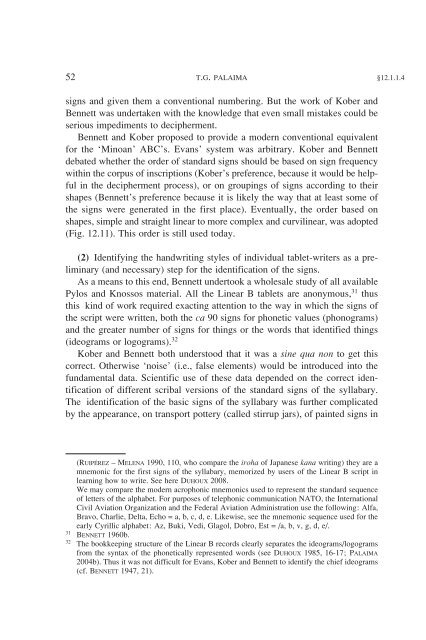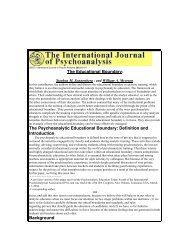A Companion to Linear B - The University of Texas at Austin
A Companion to Linear B - The University of Texas at Austin
A Companion to Linear B - The University of Texas at Austin
Create successful ePaper yourself
Turn your PDF publications into a flip-book with our unique Google optimized e-Paper software.
52 T.G. PALAIMA §12.1.1.4<br />
signs and given them a conventional numbering. But the work <strong>of</strong> Kober and<br />
Bennett was undertaken with the knowledge th<strong>at</strong> even small mistakes could be<br />
serious impediments <strong>to</strong> decipherment.<br />
Bennett and Kober proposed <strong>to</strong> provide a modern conventional equivalent<br />
for the ‘Minoan’ ABC’s. Evans’ system was arbitrary. Kober and Bennett<br />
deb<strong>at</strong>ed whether the order <strong>of</strong> standard signs should be based on sign frequency<br />
within the corpus <strong>of</strong> inscriptions (Kober’s preference, because it would be helpful<br />
in the decipherment process), or on groupings <strong>of</strong> signs according <strong>to</strong> their<br />
shapes (Bennett’s preference because it is likely the way th<strong>at</strong> <strong>at</strong> least some <strong>of</strong><br />
the signs were gener<strong>at</strong>ed in the first place). Eventually, the order based on<br />
shapes, simple and straight linear <strong>to</strong> more complex and curvilinear, was adopted<br />
(Fig. 12.11). This order is still used <strong>to</strong>day.<br />
(2) Identifying the handwriting styles <strong>of</strong> individual tablet-writers as a preliminary<br />
(and necessary) step for the identific<strong>at</strong>ion <strong>of</strong> the signs.<br />
As a means <strong>to</strong> this end, Bennett under<strong>to</strong>ok a wholesale study <strong>of</strong> all available<br />
Pylos and Knossos m<strong>at</strong>erial. All the <strong>Linear</strong> B tablets are anonymous, 31 thus<br />
this kind <strong>of</strong> work required exacting <strong>at</strong>tention <strong>to</strong> the way in which the signs <strong>of</strong><br />
the script were written, both the ca 90 signs for phonetic values (phonograms)<br />
and the gre<strong>at</strong>er number <strong>of</strong> signs for things or the words th<strong>at</strong> identified things<br />
(ideograms or logograms). 32<br />
Kober and Bennett both unders<strong>to</strong>od th<strong>at</strong> it was a sine qua non <strong>to</strong> get this<br />
correct. Otherwise ‘noise’ (i.e., false elements) would be introduced in<strong>to</strong> the<br />
fundamental d<strong>at</strong>a. Scientific use <strong>of</strong> these d<strong>at</strong>a depended on the correct identific<strong>at</strong>ion<br />
<strong>of</strong> different scribal versions <strong>of</strong> the standard signs <strong>of</strong> the syllabary.<br />
<strong>The</strong> identific<strong>at</strong>ion <strong>of</strong> the basic signs <strong>of</strong> the syllabary was further complic<strong>at</strong>ed<br />
by the appearance, on transport pottery (called stirrup jars), <strong>of</strong> painted signs in<br />
(RUIPÉREZ – MELENA 1990, 110, who compare the iroha <strong>of</strong> Japanese kana writing) they are a<br />
mnemonic for the first signs <strong>of</strong> the syllabary, memorized by users <strong>of</strong> the <strong>Linear</strong> B script in<br />
learning how <strong>to</strong> write. See here DUHOUX 2008.<br />
We may compare the modern acrophonic mnemonics used <strong>to</strong> represent the standard sequence<br />
<strong>of</strong> letters <strong>of</strong> the alphabet. For purposes <strong>of</strong> telephonic communic<strong>at</strong>ion NATO, the Intern<strong>at</strong>ional<br />
Civil Avi<strong>at</strong>ion Organiz<strong>at</strong>ion and the Federal Avi<strong>at</strong>ion Administr<strong>at</strong>ion use the following: Alfa,<br />
Bravo, Charlie, Delta, Echo = a, b, c, d, e. Likewise, see the mnemonic sequence used for the<br />
early Cyrillic alphabet: Az, Buki, Vedi, Glagol, Dobro, Est = /a, b, v, g, d, e/.<br />
31 BENNETT 1960b.<br />
32 <strong>The</strong> bookkeeping structure <strong>of</strong> the <strong>Linear</strong> B records clearly separ<strong>at</strong>es the ideograms/logograms<br />
from the syntax <strong>of</strong> the phonetically represented words (see DUHOUX 1985, 16-17; PALAIMA<br />
2004b). Thus it was not difficult for Evans, Kober and Bennett <strong>to</strong> identify the chief ideograms<br />
(cf. BENNETT 1947, 21).

















